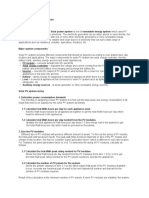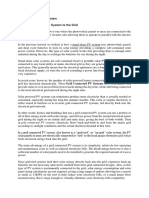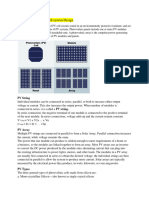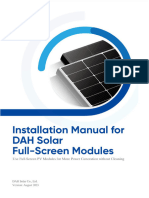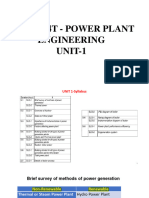By Dale A Gulden, Solar Direct CEO
By Dale A Gulden, Solar Direct CEO
Uploaded by
Abdulkhadir SuhairCopyright:
Available Formats
By Dale A Gulden, Solar Direct CEO
By Dale A Gulden, Solar Direct CEO
Uploaded by
Abdulkhadir SuhairOriginal Description:
Original Title
Copyright
Available Formats
Share this document
Did you find this document useful?
Is this content inappropriate?
Copyright:
Available Formats
By Dale A Gulden, Solar Direct CEO
By Dale A Gulden, Solar Direct CEO
Uploaded by
Abdulkhadir SuhairCopyright:
Available Formats
By Dale A Gulden, Solar Direct CEO
Solar Electric Basic Components
1. Modules solar electric collectors. 3 basic types in the marketplace:
Mono crystalline, poly crystalline, thin film
2. Array modules connected together into a system 3. Inverter converts the DC power produced by the modules to A/C
4. Grid Tie Inverter converts DC to AC and feeds the utility grid
with the A/C power
5. Charge Controller regulates the power going to the batteries 6. Batteries stores DC power
Solar Electric Types of Systems
Each type has very specific capabilities and limitations All PV systems consist of one or more modules which produce DC power. It is what is done with this power after it is produced that determines the type of system.
Stand Alone Off grid
Modules, charge controller, batteries, and may or may not have an inverter which converts DC power to A/c power
Grid Tie Grid connected
Modules, and inverter connected to the power grid
Hybrid Grid connected with batteries
Modules, grid-tie inverter, and batteries for storage when the grid is unavailable
Systems can be installed on roofs, ground racks, pole mounts, or on racks which track the sun.
Stand Alone Off Grid Systems
Stand-alone PV systems are designed to operate independent of the electric utility grid, and are generally designed and sized to supply certain DC and/or AC electrical loads. Common applications are direct power to DC loads, water pumping and telecommunications. With an inverter it can also power AC loads For systems with no battery the energy is used immediately; only works when it's sunny Systems with Battery Backup can supply power 100% of the time: At night, on cloudy days and when the utility power is down
Stand Alone Off Grid Installation
Stand Alone Off Grid System Components
Grid Tie Grid Connected Systems
Grid Tie System is the simplest and most cost effective way to connect PV modules to regular utility power. Grid-Connected systems can supply solar power to your home and use utility power as a backup.
As long as there is enough electricity flowing in from your PV system, no electricity will flow in from the utility company.
If your system is generating more power than you are using, the excess will flow back into the grid, turning your meter backwards.
Grid Tie Grid Connected - Rack Installations
Grid Tie Grid Connected - Roof Installations
Grid Tie Grid Connected System Components
Hybrid Grid Connected with Batteries
If utility power is reliable and well maintained in your area, and energy storage is not a priority, you don't necessarily need a battery. But if the utility power goes down, even if there is solar, the PV system will be off for the safety of the utility workers.
Systems with Battery can supply power 100% of the time.
Hybrid Grid Connected with Batteries - Roof Installation
Hybrid Grid Connected with Batteries - Rack Installation
Hybrid Grid Connected with Batteries - Components
Consulting, Design and Installation
Solar Electric System 11.5 kW grid-connected
Solar Water Heater PT50 connected to 2 Tank-less natural gas heaters
Solar Direct provided Consulting, Design & Installation of Solar Systems for new home construction.
Solar Pool Heater 13 Vortex panel solar automated pool system
Solar Energy Financial Incentives for Floridians
Photovoltaics - Residential
Federal Tax Credit of 30% of installed system cost through 2016 Florida Solar Rebate Program ($4/Watt up to $20,000) Florida Sales and Property Tax Exemption Utility Company Rebates Net Metering
Photovoltaics - Business
Federal Investment Tax Credit of 30% of installed system cost (available as a grant for tax years 2009 and 2010) through 2016 Florida Solar Rebate Program ($4/Watt, up to $100,000) Florida Sales Tax Exemption Utility Company Rebates Net-Metering (up to 2 MW)
Net Metering
With Net Metering you can benefit from laws and regulations that require "net" electric meter reading.
How it Works:
The customer is billed for the net electricity purchased from the utility over the entire billing periodthat is, the difference between the electricity coming from the power grid and the electricity generated by the PV system. Through net metering, the customer obtains the full retail electricity raterather than the much lower wholesale rate for kilowatt-hours of PV- produced electricity sent to the utility power grid.
Utility Incentives
City of Tallahassee: $450 SWH Rebate (residential) GRU
o o
Residential: $500 SWH Rebate; $1.50/Watt PV Rebate ($7,500 cap) Business: $500 SWH Rebate; Feed in Tariff for PV
Gulf Power: $1,000 SWH Rebate (residential, one year pilot) JEA
o o o
Residential: $400-$800 SWH Rebate Business: 15% ($2,500 cap) or 30% ($5,000 cap) SWH Rebate Local vendor garners larger rebate
Utility Incentives
OUC
o o o o
Production credit: $.03/kWh equivalent for SWH Production credit: $.05/kWh for PV Available for residential and business customers Low interest loans available for residential customers
Progress Energy: $450 SWH Rebate (residential, with load management control and load management credit) Clay Electric: $.01/Btu SWH Rebate (residential) Orange County: Residents who receive power from OUC and Progress Energy can receive a $200 incentive for the installation of a solar water heater
Do You Have Any Questions?
www.solardirect.com
800-333-9276
You might also like
- Photovoltaic Design and Installation For DummiesFrom EverandPhotovoltaic Design and Installation For DummiesRating: 4.5 out of 5 stars4.5/5 (16)
- Solar PV Minigrid Systems - Design, Installation, Operation & Maintenance Guidelines HandbookDocument162 pagesSolar PV Minigrid Systems - Design, Installation, Operation & Maintenance Guidelines HandbookDwipen BoruahNo ratings yet
- How To Design Solar PV SystemDocument53 pagesHow To Design Solar PV SystemVer Bautista100% (4)
- Guide To The Installation of Photovoltaic SystemsDocument124 pagesGuide To The Installation of Photovoltaic SystemsWorcester Renewables100% (21)
- Handbook For Solar PV SystemsDocument64 pagesHandbook For Solar PV SystemsFrancisco José Murias Dominguez100% (6)
- Top 40 Costly Mistakes Solar Newbies Make Your Smart Guide to Solar Powered Home and BusinessFrom EverandTop 40 Costly Mistakes Solar Newbies Make Your Smart Guide to Solar Powered Home and BusinessRating: 3 out of 5 stars3/5 (3)
- ACMA Aftermarket ReportDocument25 pagesACMA Aftermarket ReportSatishNo ratings yet
- Cepalco Kirahon 1 Decision,+ERC+Case+No.+2014-020+RCDocument29 pagesCepalco Kirahon 1 Decision,+ERC+Case+No.+2014-020+RCSamMooreNo ratings yet
- Design and Sizing of Solar Photovoltaic Systems R2Document125 pagesDesign and Sizing of Solar Photovoltaic Systems R2Andrei TaranuNo ratings yet
- Guide To Installing Solar PV For HouseholdsDocument28 pagesGuide To Installing Solar PV For HouseholdsPraful KakdeNo ratings yet
- Solar Power for Sustainable Living: What to Consider Before Going the Do It Yourself Solar RouteFrom EverandSolar Power for Sustainable Living: What to Consider Before Going the Do It Yourself Solar RouteRating: 5 out of 5 stars5/5 (3)
- Basic Off-grid & On-grid Design Solar Systems from Scratch: Bonus: Guide to Project Design in Autodesk© Autocad©.From EverandBasic Off-grid & On-grid Design Solar Systems from Scratch: Bonus: Guide to Project Design in Autodesk© Autocad©.Rating: 5 out of 5 stars5/5 (1)
- Solar PV CourseDocument126 pagesSolar PV Coursekeith1367294% (17)
- Handbook For Solar PV Systems PDFDocument64 pagesHandbook For Solar PV Systems PDFyassine633No ratings yet
- PhotovoltaicsDocument194 pagesPhotovoltaicsKeyur Mehta100% (7)
- How To Design Solar PV SystemDocument3 pagesHow To Design Solar PV SystemMeena DhillonNo ratings yet
- Practical PhotovoltaicsDocument206 pagesPractical Photovoltaicspcbstep100% (4)
- Engineering Photovoltaic Systems 1 - 2010Document43 pagesEngineering Photovoltaic Systems 1 - 2010Joshua Pearce100% (9)
- Manual Guide For PVDocument40 pagesManual Guide For PVRahmawati AgustinNo ratings yet
- Photovoltaic Systems - Buyer's GuideDocument52 pagesPhotovoltaic Systems - Buyer's GuideDanny Lister80% (5)
- Solar Power BasicsDocument102 pagesSolar Power BasicsRam Prasad100% (9)
- Solar PV Installation - Training Handbook 2017Document124 pagesSolar PV Installation - Training Handbook 2017VIJAYARAGAVAN MOORTHY100% (4)
- Stand Alone Photovoltaic SystemsDocument438 pagesStand Alone Photovoltaic SystemsClearMind8450% (4)
- Solar Power Design ManualDocument65 pagesSolar Power Design ManualMiroslav Ilić96% (24)
- PV System DesignDocument96 pagesPV System DesignSourabh Banerjee100% (4)
- Engineering Photovoltaic Systems 2: 2010Document47 pagesEngineering Photovoltaic Systems 2: 2010Joshua Pearce100% (1)
- Solar Photovoltaic Power System HandbookDocument22 pagesSolar Photovoltaic Power System HandbookGeroldo 'Rollie' L. Querijero100% (2)
- Solar PV Training Pv-2Document72 pagesSolar PV Training Pv-2jayminray100% (2)
- Training Manual For Engineers On Solar PV SystemDocument258 pagesTraining Manual For Engineers On Solar PV Systemadmercano96% (23)
- Sizing and Cost Estimation Methodology For Stand Alone Residential PV Power SystemDocument20 pagesSizing and Cost Estimation Methodology For Stand Alone Residential PV Power SystemvenvettyNo ratings yet
- TH - EnglishDocument87 pagesTH - EnglishBacamarteNo ratings yet
- Photovoltaic Design PDFDocument79 pagesPhotovoltaic Design PDFilm112800100% (5)
- Photovoltaic EnergyDocument16 pagesPhotovoltaic EnergySandeep Satav100% (1)
- Pvsyst Steps To DesignDocument27 pagesPvsyst Steps To Designab_s503688% (8)
- PV System Design-Stand Alone Ac SystemDocument7 pagesPV System Design-Stand Alone Ac SystemTapera Mangezi100% (9)
- Solar PV DesignDocument63 pagesSolar PV DesignSourabh Banerjee90% (10)
- Design Guidelines For 30 100 KW SystemsDocument22 pagesDesign Guidelines For 30 100 KW SystemsMaan ENo ratings yet
- PVsyst TutorialDocument107 pagesPVsyst TutorialAdewale Bamgbade100% (1)
- How to Install & Design Solar Panels like a Professional: Save Thousands by Doing It Yourself: Power All Your Projects with the Power of the SunFrom EverandHow to Install & Design Solar Panels like a Professional: Save Thousands by Doing It Yourself: Power All Your Projects with the Power of the SunRating: 3 out of 5 stars3/5 (1)
- Decoding the Installation of Solar Panels: 1st Edition: How to Create and Calculate Your Photovoltaic Systems for Any ApplicationFrom EverandDecoding the Installation of Solar Panels: 1st Edition: How to Create and Calculate Your Photovoltaic Systems for Any ApplicationNo ratings yet
- The Ultimate Solar Power Design Guide Less Theory More PracticeFrom EverandThe Ultimate Solar Power Design Guide Less Theory More PracticeRating: 4.5 out of 5 stars4.5/5 (10)
- Grid Connected PV System Connecting Your Solar System To The GridDocument18 pagesGrid Connected PV System Connecting Your Solar System To The GridNANDHAKUMAR ANo ratings yet
- Grid Connected PV System: More InfoDocument11 pagesGrid Connected PV System: More Infosai karthikNo ratings yet
- 2011 Consumer Residential PDFDocument27 pages2011 Consumer Residential PDFKeiko JeyaNo ratings yet
- 2011 Consumer ResidentialDocument27 pages2011 Consumer ResidentialSalahuddin MughalNo ratings yet
- Experiment No10BME6 - SolarDocument6 pagesExperiment No10BME6 - SolarSolo RapidNo ratings yet
- U.S. Department of Energy Solar Photovoltaic System GuideDocument20 pagesU.S. Department of Energy Solar Photovoltaic System Guidecatersolar100% (7)
- Get Your Power From Thesun: A Consumer'S GuideDocument20 pagesGet Your Power From Thesun: A Consumer'S GuideRokan ZamanNo ratings yet
- Homeowners Guide To Solar PVDocument5 pagesHomeowners Guide To Solar PVpaulNo ratings yet
- EE-ELECTIVESDocument13 pagesEE-ELECTIVESjieverneil.austriaNo ratings yet
- Big 2 What is the Relationship Between InverterDocument18 pagesBig 2 What is the Relationship Between Inverterjoseph kalejiNo ratings yet
- Photovoltaic System TypesDocument3 pagesPhotovoltaic System Typesanmn123No ratings yet
- Frequently Asked Questions: About Solar PowerDocument2 pagesFrequently Asked Questions: About Solar PowerService Solahart 081313462267No ratings yet
- Non Con PpttDocument30 pagesNon Con Pptt22u211No ratings yet
- Block Diagram of A Photo Voltaic SystemDocument3 pagesBlock Diagram of A Photo Voltaic Systemkeshav246100% (1)
- Solar Cell System Design-2Document12 pagesSolar Cell System Design-2spotifyladderNo ratings yet
- Rooftop Solar Power PlantDocument13 pagesRooftop Solar Power PlantashishNo ratings yet
- Role of Solar Farm in Power Factor Improvement of Grid Connected SystemDocument13 pagesRole of Solar Farm in Power Factor Improvement of Grid Connected SystemAniketNo ratings yet
- 1111111111111111111111111111trainingggg Manual 18686Document16 pages1111111111111111111111111111trainingggg Manual 18686Sunil SinghNo ratings yet
- Photovoltaic System ConfigurationsDocument4 pagesPhotovoltaic System Configurationsstuff93No ratings yet
- Solar Electricity Basics: Solar Electric System ComponentsDocument12 pagesSolar Electricity Basics: Solar Electric System ComponentssebascianNo ratings yet
- Vakkom Abdul Khader MoulaviDocument1 pageVakkom Abdul Khader MoulaviAbdulkhadir Suhair100% (1)
- PertDocument11 pagesPertAbdulkhadir SuhairNo ratings yet
- 107 RenaissancePeriodPresentationDocument31 pages107 RenaissancePeriodPresentationMarcos Dos SantosNo ratings yet
- If The World Were A Village of 100 PeopleDocument20 pagesIf The World Were A Village of 100 PeopleAbdulkhadir SuhairNo ratings yet
- The CrusadesDocument8 pagesThe CrusadesAbdulkhadir SuhairNo ratings yet
- Lineage February 2013Document17 pagesLineage February 2013Abdulkhadir SuhairNo ratings yet
- The CrusadesDocument8 pagesThe CrusadesAbdulkhadir SuhairNo ratings yet
- The Evaluation of Organizational PerformanceDocument13 pagesThe Evaluation of Organizational PerformanceAbdulkhadir SuhairNo ratings yet
- Lineage June 2013Document12 pagesLineage June 2013Abdulkhadir SuhairNo ratings yet
- ch20 Sec1Document14 pagesch20 Sec1vmonacelli5770No ratings yet
- Cain Project - A Guide To Designing A PosterDocument6 pagesCain Project - A Guide To Designing A PosterAbdulkhadir SuhairNo ratings yet
- The Importance of Engineering To SocietyDocument29 pagesThe Importance of Engineering To Societybarat378680% (10)
- Anert PresentationDocument15 pagesAnert PresentationAbdulkhadir SuhairNo ratings yet
- Speech On Vakkom Moulavi by Shri Chief Minister Shri Oommen ChandyDocument4 pagesSpeech On Vakkom Moulavi by Shri Chief Minister Shri Oommen ChandyAbdulkhadir SuhairNo ratings yet
- IEEE India Council Newsletter May 2013Document28 pagesIEEE India Council Newsletter May 2013Abdulkhadir SuhairNo ratings yet
- Implementing A Utility Geographic Information System For Water, Sewer, and Electric - DCrawfordDocument19 pagesImplementing A Utility Geographic Information System For Water, Sewer, and Electric - DCrawfordAbdulkhadir SuhairNo ratings yet
- Poster Design TipsDocument5 pagesPoster Design TipsAbdulkhadir SuhairNo ratings yet
- Enterprise Gis Smart Electric GridDocument11 pagesEnterprise Gis Smart Electric GridAbdulkhadir Suhair100% (1)
- Tesla Megapack DatasheetDocument3 pagesTesla Megapack DatasheetMukesh RajasekarNo ratings yet
- Introduction To Optoelectronics: Ronette S. Garcia Bsee-IvDocument37 pagesIntroduction To Optoelectronics: Ronette S. Garcia Bsee-IvRv Abejo AngaganNo ratings yet
- Inverter, Battery, Suntree - Pricing (2025.06.27)Document3 pagesInverter, Battery, Suntree - Pricing (2025.06.27)triplea.npwconstructionNo ratings yet
- EN671 Lecture 7 SPV1Document20 pagesEN671 Lecture 7 SPV1percy jacksonNo ratings yet
- Installation Manual For DAH Solar Full-Screen Modules-Version 2.0Document22 pagesInstallation Manual For DAH Solar Full-Screen Modules-Version 2.0ianalpar717No ratings yet
- Protection of DC Microgrids Based On Complex Power During Faults in On Off-Grid ScenariosDocument11 pagesProtection of DC Microgrids Based On Complex Power During Faults in On Off-Grid ScenariosNahil ShakerNo ratings yet
- Solar Permitting Guidebook - 2017Document130 pagesSolar Permitting Guidebook - 2017Alo100% (1)
- Petal Shaped Nanoantenna For Solar Energy HarvestingDocument9 pagesPetal Shaped Nanoantenna For Solar Energy HarvestingDody AliNo ratings yet
- Ecology Extra CreditDocument6 pagesEcology Extra CreditRandy EtheleauNo ratings yet
- Petrova-Koch v. High-Efficient Low-Cost Photovoltaics... 2ed 2020Document319 pagesPetrova-Koch v. High-Efficient Low-Cost Photovoltaics... 2ed 2020Cio CorrsNo ratings yet
- Problems: Photovoltaics: EUB - 7 - 133 Renewable Energy Technologies 1Document6 pagesProblems: Photovoltaics: EUB - 7 - 133 Renewable Energy Technologies 1mdmarufur100% (1)
- Datasheet - Perc - H - M - 400W - 405W - 410W - 415W-V3 - 2014-1002-35Document2 pagesDatasheet - Perc - H - M - 400W - 405W - 410W - 415W-V3 - 2014-1002-35Haifa MabroukNo ratings yet
- Energy Conversion and Management: Daniel Chemisana, Joan Ignasi RosellDocument8 pagesEnergy Conversion and Management: Daniel Chemisana, Joan Ignasi RosellElie ZorbaNo ratings yet
- Project Ip SampleDocument19 pagesProject Ip SampleNori Jayne Cosa RubisNo ratings yet
- Compact NSX, Compact Ins Inv and Masterpact NW - DC - DC PV CatalogueDocument296 pagesCompact NSX, Compact Ins Inv and Masterpact NW - DC - DC PV CatalogueRodolfoAntonioLeónCárdenas0% (1)
- Solar CellDocument38 pagesSolar CellPrudhvinadh KopparapuNo ratings yet
- Augwind's Compressed Air Tech For Renewables StorageDocument8 pagesAugwind's Compressed Air Tech For Renewables StoragebillthegunmNo ratings yet
- 01 - First Solar Datasheet - Annexure A1Document2 pages01 - First Solar Datasheet - Annexure A1avadhdangayachNo ratings yet
- World Energy: InvestmentDocument12 pagesWorld Energy: Investmentatul26kumar6897No ratings yet
- Unit 1Document44 pagesUnit 1eswar.p210No ratings yet
- Design, Modeling and Testing of A Standalone Single-Axis Active Solar Tracker Using MATLAB/SimulinkDocument20 pagesDesign, Modeling and Testing of A Standalone Single-Axis Active Solar Tracker Using MATLAB/SimulinkVishal FernandesNo ratings yet
- Ilovepdf MergedDocument49 pagesIlovepdf MergedLalitha LatchanaNo ratings yet
- Renewable Energy Technology: Dr. Md. Rifat HazariDocument26 pagesRenewable Energy Technology: Dr. Md. Rifat HazariAlamin KhanNo ratings yet
- How Should I Design Earthing of A Solar Plant - QuoraDocument7 pagesHow Should I Design Earthing of A Solar Plant - QuoraMuhammed MekkiNo ratings yet
- FM Global Property Loss Prevention Data Sheets: List of FiguresDocument28 pagesFM Global Property Loss Prevention Data Sheets: List of FiguresBogdan BranisteanuNo ratings yet
- Zonergy CatalogDocument19 pagesZonergy CatalogSuban Tasir0% (1)
- Literature Review On Solar CellsDocument6 pagesLiterature Review On Solar Cellsea793wsz100% (1)
- Solar Panel Prices in Lahore, PakistanDocument13 pagesSolar Panel Prices in Lahore, PakistanAmmar YasirNo ratings yet















